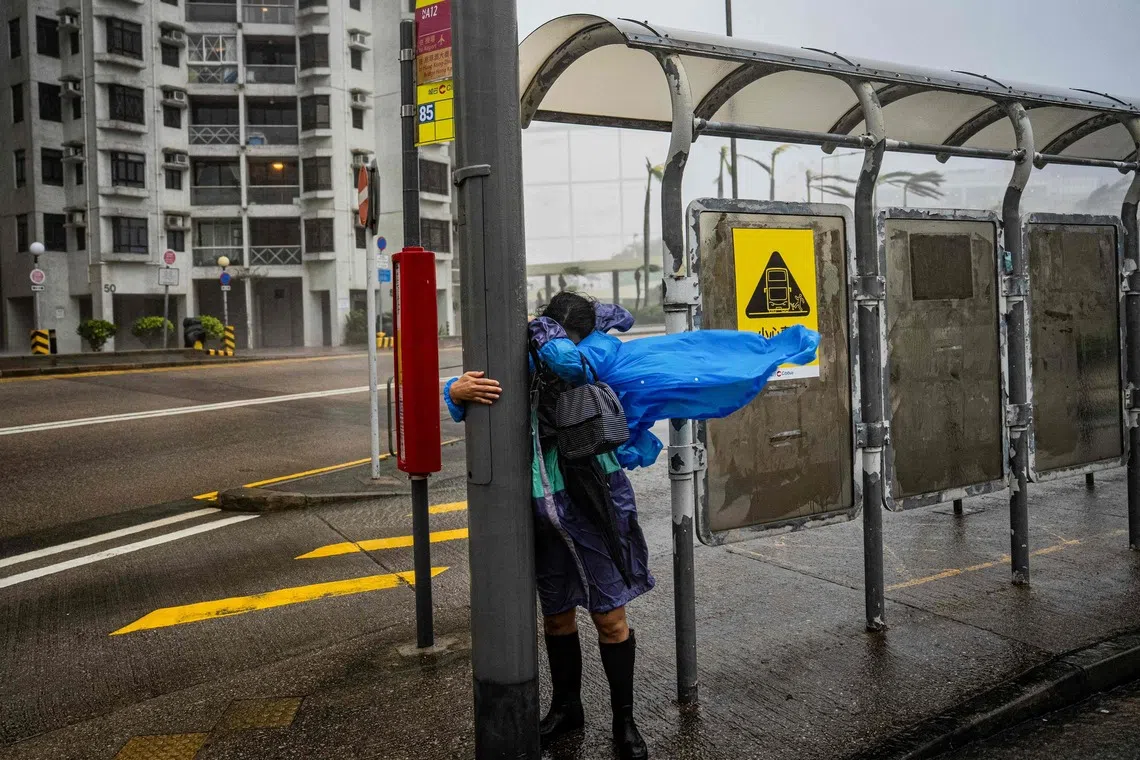HK’s record-breaking typhoon season spurs warnings to invest in more climate-ready measures
Sign up now: Get insights on Asia's fast-moving developments

A woman holding on to a lamp post in Hong Kong as Super Typhoon Ragasa hits the city on Sept 24.
PHOTO: AFP
Follow topic:
- Hong Kong faces a record typhoon season in 2025, with 12 typhoons triggering warnings, while the annual average is six.
- Climate change intensifies typhoons like Super Typhoon Ragasa, causing considerable damage and highlighting the need for stronger climate adaptation measures.
- Experts urge Hong Kong to invest in resilient infrastructure, regulate high-risk properties, and address the vulnerability of rooftop dwellers to mitigate future harm.
AI generated
HONG KONG – This city is experiencing a record-breaking typhoon season in 2025, seeing the most number of such storms in a year since its weather agency’s records started more than a century ago.
Typhoon Matmo, which passed near the city on Oct 4 and 5
Historically, the city experiences around six typhoons annually, according to a City University of Hong Kong study.
Matmo came just over a week after Super Typhoon Ragasa pummelled Hong Kong on Sept 24, causing costly damage to buildings and power outages in some areas, although the city’s early planning and preparations beforehand
One of the most powerful typhoons in Hong Kong’s history, Ragasa’s intensity was likely worsened by human-driven climate change, according to a study released by French research group ClimaMeter in late September.
Indeed, while climate change is not thought to have increased the number of hurricanes, typhoons and storms worldwide, it is causing them to grow in intensity, bringing about a greater adverse impact on the city’s environment and the lives of its people, said analysts.
They warned that Hong Kong needs to invest in stronger climate adaptation measures urgently to mitigate the potential harm of these storms.
“Typhoons are no longer seasonal anomalies – they’re structural threats,” Professor Benjamin Horton, dean of the City University of Hong Kong’s school of energy and environment, told The Straits Times.
“Hong Kong must treat climate resilience as a core pillar of its urban future, not a reactive measure,” he said.
Ragasa had been closely preceded in Hong Kong by severe tropical storms Tapah and Mitag in September, both of which caused localised flooding, felled numerous trees and damaged some street signs, lamp posts, scaffolding structures and other facilities.
The city’s waterfront districts and informal housing communities remain dangerously exposed as typhoons intensify, Prof Horton said.
While the government has invested in drainage tunnels and coastal defences, many private buildings and businesses still lack mandatory flood-proofing measures.
Storm surges during Ragasa’s recent onslaught flooded coastal and low-lying areas across the city, with waves breaching buildings and businesses along promenades and even shattering a wall of glass at the lobby of the luxury Fullerton Ocean Park Hotel.
“Stronger regulations are needed to ensure that properties in high-risk zones are equipped with barriers, elevated systems and climate-resilient designs,” Prof Horton said.
Equally urgent, he added, is the situation of rooftop dwellers – the thousands of families who live in flimsy, often illegal structures that offer little protection against extreme weather.
A viral video that made its rounds during Ragasa showing a rooftop shack in the seaside town of Sai Kung, with its roof completely blown off by the typhoon, demonstrated the risks faced by those who live within such structures.
“Rehousing or regulating these communities must become a priority,” Prof Horton said.
“We can build higher walls and stronger barriers, but if we leave thousands exposed on rooftops and in flood-prone tenements, we’re not solving the problem – we’re just shifting the risk,” he warned.
Hong Kong has to make “substantial changes” to its approach in disaster preparedness and urban planning as the frequency and intensity of such adverse weather events rise, said Lingnan University’s Professor Yau Yung.
“It is essential for the government to invest in stronger and more resilient infrastructure, such as adding to the city’s existing underground storm water storage systems,” Prof Yau, a professional member of Britain’s Royal Institution of Chartered Surveyors, told ST.
While the authorities should help reinforce people’s homes and businesses to withstand more severe weather events, individuals and business owners should also look into enhancing their typhoon insurance coverage as they may face greater financial risks from property damage and economic disruptions, he said.
“All these measures may incur higher costs, but are necessary for the city’s long-term sustainability,” Prof Yau added.
Worsening climate change could have a significant impact on typhoon-prone Hong Kong and its economy, said Assistant Professor Gianmarco Mengaldo, a co-author of the ClimaMeter report on Ragasa.
“The likelihood of powerful storms exhibiting greater intensity, with heavier precipitation and stronger winds, rises in a warmer climate,” Prof Mengaldo, from the National University of Singapore’s department of mechanical engineering, told ST.
“Hong Kong’s dense urban environment, coastal exposure and proximity to major storm tracks make it particularly vulnerable to disruption from typhoons. A clear example is the complete shutdown of international travel and supply chains when its airport and (sea)port are closed, leading to potentially severe economic consequences,” he said.
While the number of typhoons each year has not yet shown any clear long-term increase, the professor said, “the frequency of the most intense events and rapid intensification episodes has risen”.
“With typhoons becoming more intense, Hong Kong and other coastal cities will need to adapt, by enhancing drainage and run-off infrastructure to handle heavier rainfall, and by accounting for storm surges that compound hydrological hazards,” he said.


